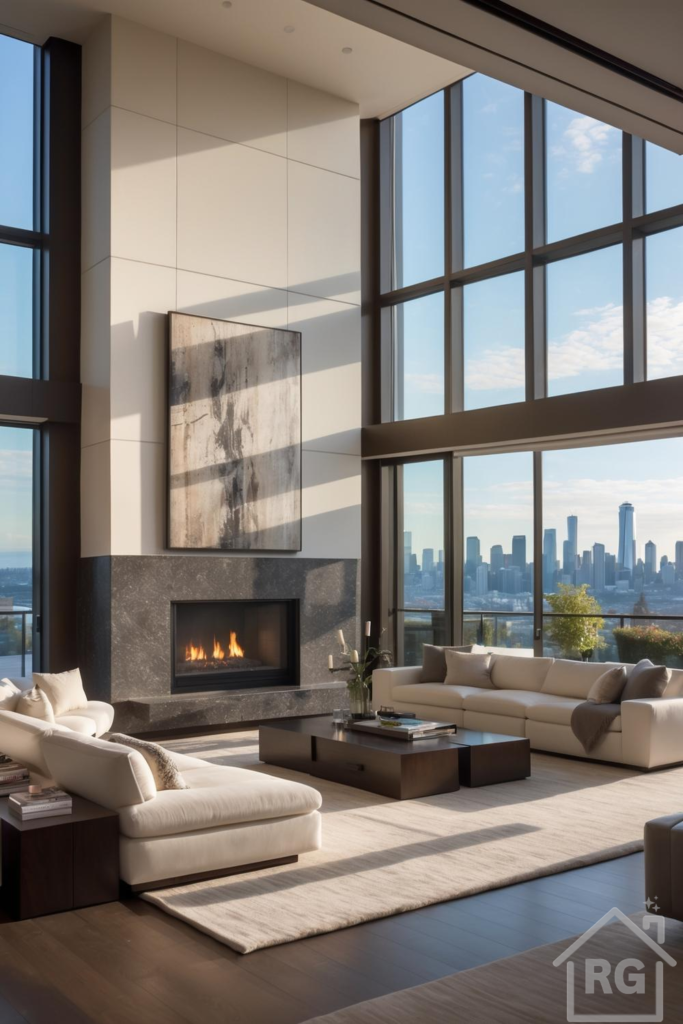
The allure of modern luxury in interior design often lies in its masterful blend of space, light, and carefully curated elements. It speaks of sophistication, comfort, and an appreciation for clean lines and high-quality materials.
Imagine stepping into a room like the one pictured: a breathtaking expanse bathed in natural light, grounded by rich textures, and offering a stunning cityscape view. This isn’t just a room; it’s an experience. Achieving this level of high-end modern design might seem daunting, but it’s rooted in understandable principles that can be adapted to various spaces and budgets.
This guide will break down the key elements, offering actionable tips to help you infuse your own home with a similar sense of urban luxury.
Principle 1: Maximize Natural Light and Embrace the View
The most striking feature of many luxurious modern homes, particularly those in urban settings, is the abundance of natural light and the integration of the surrounding view. The inspiration image perfectly exemplifies this with its dramatic floor-to-ceiling windows.
- Window Design: Large, minimally obstructed windows are crucial. If building or renovating, prioritize expansive glass panels. Consider dark frames, as seen in the image, which can paradoxically make the view ‘pop’ by framing it distinctly.
- Window Treatments: Keep them minimal or absent if privacy allows. If needed, opt for sleek, unobtrusive options like recessed roller shades (in sheer or blackout fabrics) or high-quality, ceiling-mounted sheer curtains that stack tightly when open. Avoid heavy drapes or fussy valances that detract from the clean lines.
- Reflective Surfaces: While not overly dominant in the example, strategically placed mirrors or glossy finishes can further amplify light, though use them judiciously to avoid a cold or overly stark feel.
- Layout: Arrange furniture to appreciate the view. Notice how the seating in the image faces both inwards for conversation and outwards towards the windows.
Principle 2: Master the Sophisticated Neutral Palette
High-end modern design often relies on a foundation of sophisticated neutrals. This doesn’t mean boring; it means creating a calm, cohesive backdrop that allows textures and forms to shine.
- Color Choices: The inspiration room uses a palette of off-whites, creams, deep charcoals/blacks, warm wood tones, and subtle beiges. This creates depth without overwhelming the senses. Key is the balance between warm (creams, woods, beige) and cool (grey, black, the blue sky outside) neutrals.
- Layering Tones: Use variations of your chosen neutrals. Different shades of grey, beige, and white add complexity. The walls are a light off-white, the sofa a slightly warmer cream, the rug incorporates multiple beige tones, and the fireplace provides a strong dark grey anchor.
- Undertones Matter: Pay attention to the undertones (cool, warm, or true neutral) of your paints and fabrics to ensure they harmonize rather than clash.
- Accent Colors (Optional): While this room is strictly neutral, a pop of muted color (like a deep teal, olive green, or terracotta) could be introduced through pillows or accessories if desired, but keep it restrained.
Principle 3: Layer Textures for Warmth and Interest
A neutral palette avoids blandness through the skillful layering of textures. This adds tactile and visual interest, making the space feel inviting and luxurious.
- Combine Materials: The image showcases a masterful mix: the smooth coolness of the stone fireplace surround contrasts with the warmth of the dark wood floor and coffee table. The soft upholstery of the sofas plays against the woven texture of the area rug. The sleekness of glass windows provides yet another layer.
- Key Textures to Consider:
- Stone/Marble: Adds a sense of permanence and luxury (fireplace, potentially tabletops).
- Wood: Brings natural warmth and grounding (flooring, furniture).
- Soft Upholstery: Invites comfort (sofas, chairs – consider velvets, linens, high-quality weaves).
- Woven Textiles: Adds dimension (area rugs, throw blankets, some pillows – think wool, jute, sisal, or synthetic blends).
- Glass & Metal: Provides sleekness and reflection (windows, table bases, lighting fixtures).
- Plaster/Smooth Walls: Creates a clean, gallery-like backdrop.
- Balance is Key: Don’t overdo it. Aim for a balanced mix where each texture complements the others without creating visual chaos.
Principle 4: Leverage Architectural Features and Statement Pieces
High ceilings and significant architectural elements like a prominent fireplace contribute immensely to the luxurious feel. If you don’t have these built-in features, focus on creating strong focal points.
- Vertical Space: Emphasize high ceilings with tall elements like floor-to-ceiling windows, tall artwork, or vertical paneling as seen subtly on the fireplace wall.
- Focal Point Fireplace: The fireplace here is a major statement – sleek, modern, and integrated into a substantial stone surround. Even a simpler modern fireplace can be enhanced with a striking surround material or a large piece of art above it.
- Large-Scale Art: The abstract painting is crucial. It adds personality, color variation (within the neutral theme), and fills the large wall space appropriately. Choose art that complements the room’s scale and style.
- Lighting as Sculpture: While not overtly visible here, consider statement pendant lights or sculptural floor lamps in other modern luxury designs to add another layer of visual interest.
Principle 5: Select Furniture with Clean Lines and Appropriate Scale
Furniture in modern luxury design is characterized by clean lines, quality materials, and comfort, scaled appropriately for the space.
- Silhouettes: Opt for furniture with simple, geometric forms. The sofas are substantial but have clean, unfussy lines. The coffee table is a simple, low rectangle.
- Scale: In a large room with high ceilings, choose substantial pieces that don’t get lost. Conversely, in smaller spaces, select appropriately scaled items to avoid overcrowding. The low profile of the seating keeps the space feeling open despite the furniture’s size.
- Comfort and Quality: Invest in well-made pieces with comfortable, durable upholstery. Luxury is as much about feel as it is about looks.
- Functionality: Ensure pieces serve their purpose well. The large coffee table provides ample surface area, and side tables offer convenience.
Principle 6: Practice Curated and Minimalist Decor
Less is often more in high-end modern design. Avoid clutter and choose accessories thoughtfully to maintain a sense of calm sophistication.
- Edit Ruthlessly: Only display items that are beautiful, meaningful, or functional. Clear surfaces are key to a modern aesthetic.
- Quality over Quantity: A few well-chosen, high-quality accessories make a bigger impact than numerous cheap trinkets.
- Strategic Placement: Group items intentionally (e.g., a stack of design books and a simple vase on the coffee table). Use the ‘rule of three’ for visually pleasing arrangements.
- Personal Touches: While minimalist, the space shouldn’t feel sterile. Include items that reflect your personality, like curated books or subtle decorative objects.
Principle 7: Integrate the Outdoors (When Applicable)
If you have a balcony, patio, or even just a great view, treat it as an extension of your living space to enhance the feeling of openness and luxury.
- Visual Connection: Keep the sightlines clear. Use similar color palettes or materials indoors and out if possible to create a seamless transition.
- Outdoor Furnishings: Choose stylish, comfortable outdoor furniture that complements the interior design.
- Greenery: Potted plants on the balcony (visible in the image) add life and soften the urban landscape, bringing a touch of nature indoors.
Achieving the Look on Different Budgets
While replicating a multi-million dollar penthouse look might be unrealistic for most, the core principles remain the same and can be adapted:
- Prioritize Investment: Spend more on key pieces that get the most use, like a comfortable sofa and a good quality area rug. These anchor the room.
- Paint Power: Never underestimate the impact of paint! A fresh coat of a sophisticated neutral paint is a cost-effective way to completely transform a space.
- Declutter Rigorously: This costs nothing but makes a huge difference in achieving a clean, modern aesthetic. Edit your belongings ruthlessly.
- Affordable Art: Create your own large-scale abstract art, frame stunning photographs, or find affordable prints online. Large art makes a big impact.
- Thrift & Secondhand Finds: Look for furniture with good bones and clean lines that can be reupholstered or refinished. Vintage markets and online marketplaces can yield treasures.
- Focus on Texture: Incorporate texture through affordable throws, pillows made from interesting fabrics, and budget-friendly rugs (like jute or sisal).
Conclusion: Your Path to Modern Luxury
Creating a high-end modern living space, inspired by luxurious city dwellings, is about more than just buying expensive things. It’s about making thoughtful design choices: maximizing light, using a sophisticated neutral palette balanced by rich textures, selecting furniture with clean lines and appropriate scale, highlighting architectural features (or creating focal points), and practicing curated minimalism.
By understanding and applying these seven principles, you can cultivate a sense of refined comfort and urban luxury in your own home, creating a space that is both visually stunning and deeply inviting.
